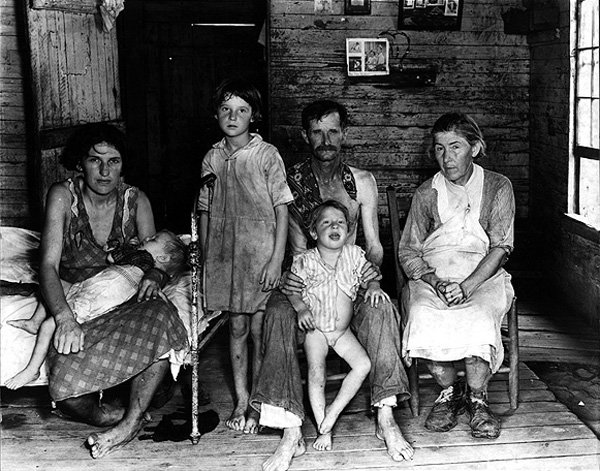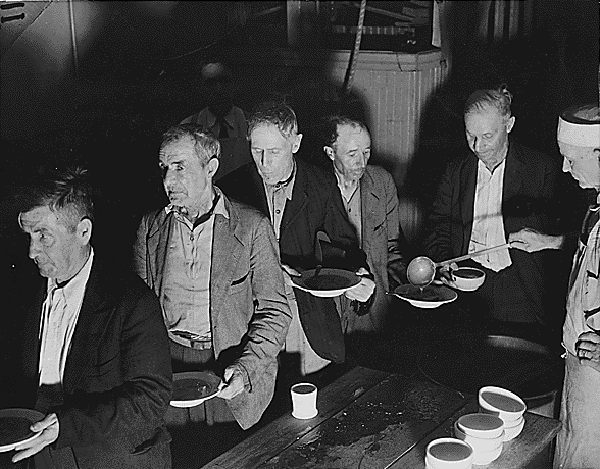The Great Depression - Page 1
The Great Depression started in the U.S. in 1929, quickly spread to every
part of the world. Most Americans lost everything as banks failed.
Great Depression
The Great Depression was a worldwide economic downturn which started in October of 1929 and lasted through most of the 1930s. It began in the United States and quickly spread to Europe and every part of the world, with devastating effects in both industrialized countries of raw materials. International trade declined sharply, as did personal incomes, tax revenues, prices and profits. Cities all around the world were hit hard, especially those dependent on heavy industry. Unemployment and homelessness soared. Construction was virtually halted in many countries. Farming and rural areas suffered as prices for crops fell by 40–60%. Mining and logging areas had perhaps the most striking blow because the demand fell sharply and there were few employment alternatives. The Great Depression ended at different times in different countries; for subsequent history see Home front during World War II. Most countries set up relief programs, and most underwent some sort of political upheaval, pushing them to the left or right. Democracy was weakened and on the defensive, as dictators such as Hitler, Stalin and Mussolini made major gains, which helped set the stage for World War II in 1939.

MIGRANT FAMILY - NATIONAL ARCHIVES

DEPRESSION SOUP LINE - NATIONAL ARCHIVES
Causes
Americans were not purchasing but saving. The only consensus viewpoint is that there was a large scale lack of confidence. Unfortunately, once panic and deflation set in, many people believed they could make more money by keeping clear of the markets as prices got lower and lower and a given amount of money bought ever more goods.
There are multiple reasons on what set off the first downturn in 1929, concerning the structural weaknesses and specific events that turned it into a major depression, and the way in which the downturn spread from country to country. In terms of the 1929 small downturn, historians emphasize structural factors like massive bank failures and the stock market crash, while economists point to Britain's decision to return to the Gold Standard
Debt
In the 1920s, in the U.S. the widespread use of purchases of businesses and factories on credit and the use of home mortgages and credit purchases of automobiles, furniture and even some stocks boosted spending but created consumer and commercial debt. People and businesses who were deeply in debt when a price deflation occurred or demand for their product decreased were often in serious trouble—even if they kept their jobs, they risked default. Many drastically cut current spending to keep up time payments thus, lowering demand for new products. Businesses began to fail as construction work and factory orders plunged. Massive layoffs occurred, resulting in unemployment rates of over 25%. Banks which had financed a lot of this debt began to fail as debtors began defaulting on debt and bank depositors became worried about their deposits and began massive withdrawals. Government guarantees and Federal Reserve banking regulations to prevent these types of panics were ineffective or not used. Bank failures led to destruction of billions of dollars in assets. Up to 40% of the available money supply normally used for purchases and bank payments was destroyed by all these bank failures.
Furthermore, the debt became heavier, because prices and incomes fell 20–50%, but the debts remained at the same dollar amount. After the panic of 1929, and during the first 10 months of 1930, 744 banks failed. In all, 9,000 banks failed during the decade of the 30s. By 1933, depositors saw $140 billion of their deposits disappear due to uninsured bank failures. Unfortunately, bank failures snowballed as desperate bankers tried calling in loans which the borrowers did not have time or money to repay. With future profits looking poor, capital investment, construction etc. slowed or completely ceased. In the face of bad loans and worsening future prospects, the surviving banks became even more conservative in their lending. They built up their capital reserves, which intensified the deflationary pressures. The vicious cycle developed and the downward spiral accelerated. This kind of self-aggravating process may have turned a 1930 recession into a 1933 depression.
In dollar terms, American exports declined from about $5.2 billion in 1929 to $1.7 billion in 1933; but prices also fell, so the physical volume of exports only fell in half. Hardest hit were farm commodities such as wheat, cotton, tobacco, and lumber. According to this theory, the collapse of farm exports caused many American farmers to default on their loans leading to the bank runs on small rural banks that characterized the early years of the Great Depression.
By not acting, the Federal Reserve allowed the money supply to shrink by one-third from 1930 to 1931. Friedman argued the downward turn in the economy starting with the stock market crash would have been just another recession. The problem wasn't some large, public bank failures, particularly the Bank of the United States, produced panic and widespread runs on local banks, and that the Federal Reserve sat idly by while banks fell. He claimed if the Fed had provided emergency lending to these key banks, or simply bought government bonds on the open market to provide liquidity and increase the quantity of money after the key banks fell, all the rest of the banks would not have fallen after the large ones did and the money supply would not have fallen to the extent and at the speed that it did. With significantly less money to go around, businessmen could not get new loans and could not even get their old loans renewed, forcing many to stop investing. This interpretation blames the Federal Reserve for inaction, especially the New York branch, which was owned and controlled by Wall Street bankers. The Federal Reserve, by design, was not controlled by the President or the U.S. Treasury; it was primarily controlled by member banks and the chairman of the Federal Reserve.
| next page >> |